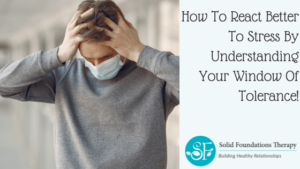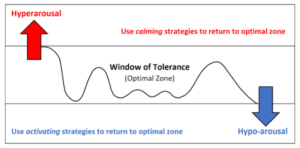
Do you notice how on certain days you are able to respond better to stress than others? Certainly it depends on the physical and emotional context under which the stress occurs, but did you know it also has to do with one’s tolerance level?
Increasing distress tolerance allows for improved emotional regulation, feeling more in control, and decreased likelihood of emotional outbursts.
One way to assess your distress tolerance is to view it through what we call the window of tolerance.
Within the window of tolerance is where the majority of people emotionally “live” on a day-to-day basis. This is the optimal zone in which conflicts can be resolved productively, people emote more rationally, and is the zone in which we thrive in daily life.

Throughout the day, our emotions and mood rise and fall due to many factors, both internal and external.
Examples of internal factors that affect mood and emotion include hormonal shifts and thoughts. External factors include one’s situations and context, such as conversations or interactions with friends or family.
To gain awareness of your own window of tolerance and what internal and external factors affect your mood, it can be helpful to journal about what fluctuations you notice and when they occur.
So why then, you may ask, is the window of tolerance so important to understand? If this is the zone of productivity and emotional regulation, then what’s the big deal?
Well, each individual’s window of tolerance size, if you will, varies. Some people can tolerate incredible levels of stress whereas others become dysregulated under small amounts of pressure.
In order to understand this concept fully it’s important to identify what happens when we rise above and dip below our window of tolerance, learn about how to regulate in those moments and identify how to expand our window of tolerance (also known as resiliency or increasing distress tolerance).
Let’s dive in to learn more about the window of tolerance and how it affects each person differently:

Zone of over-activation, also known as hyper-arousal: When stress increases, one’s tolerance level is pushed to its maximum limit, raising you out of the window of tolerance into hyperarousal. With the prefix “hyper,” I’m sure you can already imagine what kind of response occurs in this state.
In terms of one’s stress response, this is the zone where “fight or flight” become our triggered reactions. Physiologically, you may experience increased heart rate, perspiring, quickened breathing rate, etc. Behaviorally, you may become fidgety, restless, and begin pacing. Cognitively, thoughts may move more rapidly, or you may become hyper-focused. In hyperarousal, the stress hormones cortisol and adrenaline increase, therefore limiting one’s ability to think and emote rationally or logically. To return to the window of tolerance from hyperarousal, one must calm the system.
There are many strategies to calm the system, but each person’s preferred strategies are personal. To determine what calming skills are best for you, it can be helpful to write in a journal about when you feel anxious or in a hyper-aroused state and become aware of what works for you.
To get started, here are some helpful calming techniques:
- Mindfulness (such as mindfully eating, taking a mindful walk)
- Deep breathing techniques (such as acupressure breathing, box breathing)
- Stretching
- Drawing or coloring
- Listening to relaxing music
- Meditation
The key factor with calming techniques is to determine those that you can use in the moment to best intervene when you feel over-activated.
For example, if you are giving a presentation at work and you notice your anxiety spiking, exhibiting symptoms such as increased heart rate, or perhaps your voice begins shaking, you can use a calming technique that is appropriate for the context that can help you re-regulate in real time. In this instance, you may stop to take a deep breath, or perhaps you could pose a question to the audience for small group discussion so that you have time to calm your system and return to your window of tolerance.
Zone of under-activation which occurs when we dip below our window of tolerance; also known as hypo-arousal. In a hypo-aroused state, motivation decreases and one may experience feelings of depression. In terms of physiological response, you may notice decreased body temperature or slowed heart rate. Behaviorally, you may feel more lethargic, become easily fatigued, and sleep more. Cognitively, you may sense more apathetic thinking or even notice dissociative symptoms. This is the “freeze/faint” aspect of our stress response system. To return to the window of tolerance from hypo-arousal, one must activate the system.
Similar to when calming the system, activation methods are plentiful but the preferred strategies depend on the individual. Again, it can be helpful to journal and practice self-awareness in order to determine which activation strategies work best for you. Some examples of activation include:
- Engaging the senses
- Eating spicy food or sour candy
- Touching a textured surface
- Using aromatic candles or essential oils to activate olfaction
- Drinking an iced beverage
- Listening to energizing music
- Engaging in vigorous breaths
- Exercising
The key factor when applying activation strategies is to consider which ones are most accessible and effective in the moment. For example, if you are having a difficult conversation with a friend and notice yourself mentally disengaging or unable to concentrate, it could be appropriate to ask to pause the conversation so that you can ground yourself through sensory activation. Again, the key here is activating yourself in real time so as to return to the optimal zone as efficiently as possible.
Now that we have learned about hyperarousal, calming techniques, hypo-arousal, and activating techniques, the question remains about how to increase one’s distress tolerance overall. This is known as resiliency and can help expand your window of tolerance in order to manage greater mood and emotion fluctuations throughout the day. While this takes time and practice, a great place to start is to return to the healthy basics: Get ample and quality sleep, practice proper nutrition, and regularly engage in physical activity.
To illustrate this, think for a moment about how you handle a stressful situation at work or school when you did not sleep well the night before. Do you become emotional? Do you lash out verbally at your colleague? Do you become disengaged and try to escape the situation?
Now imagine that you are hungry (or as some people say, “hangry”) and encounter a difficult person in public. What are your typical reactions in that moment? It is likely that you are less apt to respond well to stress when your basic biological needs are not being met. It sounds so simple, but establishing a foundation of healthy living is a great way to start practicing increased distress tolerance to become more resilient and function more optimally.
I hope these examples help you determine your window of tolerance as it relates to stressful situations in life.
Remember, everyone goes through stress in life but how you handle that stress makes a great impact on your relationship with others.
If you find yourself struggling to handle the stress you are experiencing in life, Solid Foundations Therapy is here to help! Learn more at solidfoundationstherapy.com or give us a call at 630-633-8532 today!

